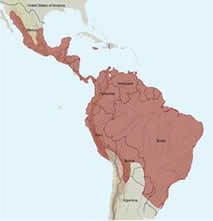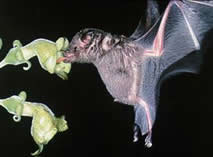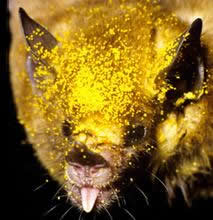Nectar Bat
Taxonomy
Kingdom Animalia
Phylum Chordata
Subphylum Vertebrata
Class Mammalia
Order Chiroptera
Family Phyllostomidae
Subfamily Glossophaginae
Life History
Average Mass: 9.60g (about 0.34 oz).
Maximum Longevity: 11 years (in captivity)
As the name common name implies, the diet of the nectar bats consists primarily on nectar, pollen, flower parts, insects, fruit, and has been known to consume parts of at least 34 different species of plants; a preference for local vegetation has also been shown (Fox, 1999).
Glossophaga soricina possess several morphological features that have been interpreted as adaptations for nectivory. Some of these features include: a very long, extendable tongue which is used for probing deep into flowers, its divergent hair scales that firmly hold pollen grains (this very important adaption means this terrestrial mammal is a very significant pollinator) and lastly, G. soricina have highly specialized digestive physiology that help facilitate digestion of nectar and pollen(Fox 1999).
Not only is G. soricina known to carry a variety of endoparasites, as well as at least 34 ectoparasites(Fox, 1999), they also serve as host to several bacterial, mycotic, protozoan and viral diseases; two of which are yellow fever in Brazil and rabies in Mexico (Ash, 2005).
 Geographical Location:
Geographical Location:
This cute little nectarivorous (Barquez et al, 2008) bat is predominantly found in regions ranging from Northern Mexico down to Paraguay and Northern Argentina, Bahamas and Jamaica.
Ecology and Behavior:
Glossophaga soricina inhabits caves, tunnels, houses, abandoned mines, hollow trees, logs, forests, buildings, culverts, and beneath bridges. Their colonies have been known to exceed 1,000 individuals (Ash, 2005) and usually host both sexes, but the females and their offspring form maternity colonies during certain times of the year. G. soricina roosts in association with many different types of bats in these dwellings.
Two general foraging behaviors have been recorded due to the observations along the north coast of Colombia (Fox, 1999). Glossophaga soricina has a night activity pattern that is bimodal (Ash, 2005); its peak activity time is right before dawn and right after dark and. Nectar bats also exhibit territoriality toward other bats especially, around their preferred food/ plants, by flying straight at the intruders on a “collision course” chasing the intruders away. Similarly, G. soricina is also known for producing a high pitched chattering vocalization, which is the only sounds made by this species that are audible to humans (Fox, 1999).
The second behavior noticed is a “trap-line” feeding behavior. Each night, Nectar bats visit a variety of plants by following the same route and monitoring the particular resource availability. Although most trap-line feeders have routes ranging between 150 and 250 m long, some Nectar bats routes have been recorded as long as 1450 m. This type of behavior is prevalent and concentrated in the first four hours after sunset (Fox, 1999). The most common feeding method of these animals can be witnessed as they feed on flowers of gourd trees by hovering over them and landing on them or by just hanging on a flower. This type of behavior is especially important in pollination because the pollen sticks to their wings, body, and head and is transferred between a varieties of plants during each feeding occasion (Fox, 2005). This feeding behavior results in a successful dispersion of seeds from economically important plants which are vital to both the plant and animal life communities.
 Reproduction
Reproduction
Since the 1970’s, Glossophaga soricina’s reproductive and development patterns have been studied extensively (Ash, 2005). With an average gestation period of 106 days, reproductive behavior somewhat varies due to geographical location. The breeding cycle of G. soricina has been described as “bimodally polyestrous” and it has been concluded that this species breed continuously throughout the year (Fox, 1999).
The ovulation and menstruation of G. soricina approximately takes place at the same time. A spontaneous ovulation occurs and alternates between each of the 2 ovaries while only one ovum is released per cycle. After fertilization by a male bat occurs, by day 2 or 3, the embryo has already reached the two-cell stage of development; the eight-cell stage occurs within the 5- 7 day window. The 32-cell stage is recognized by day 8 and then the blastocyst stage is achieved by the 10th day. The embryo is contained within the ampulla of the oviduct until about day 12-13 and implantation occurs around day 12-14 (Alverez et al, 1991). As mentioned before, an average period of gestation is about 106 days and young pups are born with much fur. Even though twins have been reported, normally only a single offspring is produced. Parental females carry their young and can continue to lactate up to 2 months. Young bats, or pups, have been observed hanging on their own at only 18 days old, but have been known to remain attached to their mother as late as 20 days old. Flight normally begins about 25 to 28 days after birth (EoL, 2011).
Conservation Status
Although there are no indications that G. soricina is threatened at the present, deforestation is a localized threat since populations are becoming scarce in the South (Barquez et al, 2008).
Recent Research
Over the years, there has been a lot of research conducted that concentrates in the various areas of how much energy is actually expended while G. soricina is in flight, how much energy is spent while they hover over vegetation while feeding and the various enzymatic mechanisms behind their “highly sugar expensive” flight.
As anyone could assume, hovering flight is extremely energetically expensive. In the article, “Dietary sugar as a direct fuel for flight in the nectarivorous bat Glossophaga soricina,” Welch et al (2008) explain that recently ingested shortly before (or during) dietary sugar can only fuel up to 30% of humans exercising muscles. In contrast, unlike humans and other mammals, nectarivorous bats, such as Glossophaga soricina, rely on their recently consumed sugar to fuel up to 78% of oxidative metabolism required for their energetically expensive hovering flight and daily energy. The only other vertebrate animal that can surpass this impressive realization is the Calypte anna and Selasphorus rufus hummingbirds. Similar experiments revealed that these certain species use up to an astonishing 95% of their ingested sugars to power their impressive flight hovering metabolism. This is considered to be a major feat by mammals, especially since humans can use only up to 30%. All experimental values were calculated by using simple indirect calorimetry, which is the measurement of O2 consumption and CO2 production rates, in combination with carbon stable isotope techniques (Welch et al, 2008).
 Similarly, another series of experiments were conducted on G. soricina by the same group gentlemen (with the addition of S.K. Hanna) where the enzymes in flight muscles and metabolic flux rates achieved during in vivo while hovering were tested and compared to that of hummingbirds. “O2 consumption rates were analyzed during hover-feeding and used to estimate the rates of ATP turnover, glucose and long-chain fatty acid oxidation per unit mass of flight muscle” (Suarez et al, 2009). It was concluded that most bats fed for less than 10 seconds while hovering and the longest recorded fed while hovering was 25 seconds. It was noted that both hummingbirds and nectar bats possess pectoralis muscles recruited for high-intensity, aerobic exercise.
Similarly, another series of experiments were conducted on G. soricina by the same group gentlemen (with the addition of S.K. Hanna) where the enzymes in flight muscles and metabolic flux rates achieved during in vivo while hovering were tested and compared to that of hummingbirds. “O2 consumption rates were analyzed during hover-feeding and used to estimate the rates of ATP turnover, glucose and long-chain fatty acid oxidation per unit mass of flight muscle” (Suarez et al, 2009). It was concluded that most bats fed for less than 10 seconds while hovering and the longest recorded fed while hovering was 25 seconds. It was noted that both hummingbirds and nectar bats possess pectoralis muscles recruited for high-intensity, aerobic exercise.
The results obtained not only further supported the hypothesis that both nectar bats and hummingbirds possessed high flux rates through enzyme catalyzed steps, but they also further supported the hypothesis that there is convergent evolution in biochemical and physiological traits between nectar bats and hummingbirds (Suarez et al, 2009).
Personal Interests
Since I have always had a fond interest in bats, I was quite eager to learn about the nectar bat. I found it interesting how crucial G. soricina role is as a pollinator throughout the tropical regions. I also found it extremely fascinating that so much research has been and is currently being conducting on these tiny little creatures in regards to their highly specialized metabolic rates and impressive flight muscles. It is quite remarkable that just their recent sugar intake can fuel up to 78% of their required daily energy. If it wasn’t for their numerous endoparasites, ectoparasites and rabies, I would have already own one as a pet.
Suggested Sites
Nectar Bat at Houston Children's Zoo
Bats in the Hummingbird Feeder
Bats feeding on nectar in Slow Motion
References
Please note that the following references may have either been removed or relocated by the webpage owners since the time this student report was created.
Fox, D. 1999. "Glossophaga soricina" (On-line), Animal Diversity Web. Accessed May 18, 2011 http://animaldiversity.ummz.umich.edu/site/accounts/information/Glossophaga_soricina.html.
"Glossophaga soricina (Pallas, 1766)". Encyclopedia of Life, available from "http://www.eol.org/pages/327431". Accessed 18 May 2011
Welch, Jr., Kenneth C., L. Gerardo Herrera, and Raul K. Suarez. "Dietary sugar as a direct fuel for flight in the nectarivorous bat Glossophaga soricina." The Journal of Experimental Biology 2111 Feb. (2008): 310-16. Web. 23 May 2011. <http://jeb.biologists.org/content/211/3/310.full.pdf+html>.
Alverez, Javier, Michael Willig, J. Knox Jones, Jr., and Wm. David Webster. "Glossophaga soricina." Mammilian Species 6 Nov. (1991): 1-7. Web. 20 May 2011.
Suarez, Raul K., K. C. Welch Jr., S. K. Hanna, and L. G. Herrera M. "Flight muscle enzymes and metabolic flux rates during hovering flight of the." Comparative Biochemistry and Physiology, Part A 1531 Feb. (2009): 136-40. Science Direct. Web. 23 May 2011.
Barquez, R., Perez, S., Miller, B. & Diaz, M. 2008. Glossophaga soricina. In: IUCN 2010. IUCN Red List of Threatened Species. Version 2010.4. <www.iucnredlist.org>. Downloaded on 20 May 2011
Ash, Richard. "Glossophaga soricina, Pallas’ Long-tongued Bat." . Ed. Chris Yahnke. Univeristy Of Wisconsin-Stevens Point, 8 Aug. 2005. Web. 20 May 2011.< http://www.uwsp.edu/biology/facilities/vertebrates/Mammals%20of%20Paraguay/Glossophaga%20soricina/Glossophaga%20soricina.htm>.